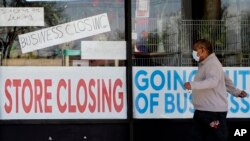The pace of applications for U.S. unemployment compensation eased again last week, the Labor Department reported Thursday, as many American employers slowly reopen their businesses after the coronavirus pandemic forced their closure.
But even as some stores, restaurants and businesses rehired workers and welcomed back customers on a restricted and limited basis, another 1.88 million workers filed for cash benefits after being laid off as the virus continues to take its toll on the world’s largest economy.
It was the smallest layoff figure since mid-March, when state governors first issued mass closure directives. But overall, 42.5 million workers have now sought unemployment compensation, more than a quarter of the U.S. labor force of more than 164 million.
However, the current actual number of jobless workers is unknown since some who sought unemployment benefits in previous weeks have now been called back to work by their employers. All 50 state governors have begun to ease restrictions on businesses opening in a patch-work array of orders that varies widely throughout the country, and even within cities and counties within individual states.
The April unemployment rate was 14.7%, with the government releasing the May figure on Friday. Some economists say it could be about 20%.
With mass protests, including numerous chaotic clashes between demonstrators and police roiling the U.S. this week against the May 25 death of a black man while in police custody, the plight of the unemployed has garnered far less attention in recent days.
Some lawmakers have been weighing whether to adopt legislation to pay workers a return-to-work bonus of $1,200 as an incentive to begin working again if they can, rather than continue to collect unemployment compensation.
The U.S. death toll from the virus has now topped 109,000, by far the most in the world, and health experts predict tens of thousands more will die in the coming months. But President Donald Trump, facing a November re-election contest against former Vice President Joe Biden, is predicting the country will have a robust economic recovery.
He almost never publicly mentions the devastating unemployment numbers.
Instead, he tweeted Wednesday: “I feel more and more confident that our economy is in the early stages of coming back very strong. Not everyone agrees with me, but I have little doubt. Watch for September, October, November. Next year will be one of the best ever, and look at the Stock Market NOW!”
But the coronavirus has had a major effect on U.S. commerce, with more than two dozen companies filing for bankruptcy protection in May and some companies announcing they were closing permanently.
The government says the national economy dropped 4.8% in the first quarter, but that was before the full impact of the pandemic became apparent for the April-to-June quarter.
Numerous states still require social distancing of at least two meters between people in stores and some major retail outlets are requiring their employees and customers to wear face masks. Some governors are limiting restaurants to half capacity or only allowing out-door eating with appropriate social distancing.
But in other states, the restrictions have been significantly lifted and crowds have quickly emerged to resume life, shopping or enjoying a day at Atlantic and Pacific beaches, often ignoring the admonitions of health experts to maintain a safe distance from others or to wear a face mask.
Federal Reserve chair Jerome Powell has warned that the American economy could endure a multi-year recession if more aid is not authorized for workers.
But Trump and Republican lawmakers are balking at approving more government assistance until it can be determined how much effect the already-approved funding is helping the economy.
U.S. workers filing for jobless benefits normally are paid slightly less than half their normal salaries. But these payments are currently being augmented during the pandemic with $600-a-week supplements from the federal government for four months, through July.
The peak of the unemployment benefit claims likely came in late March with 6.9 million workers filing for the jobless compensation in one seven-day period.
The weekly pace of claims has diminished each of the last 11 weeks since then, but the millions of claims have still been unparalleled over decades of U.S. economic history, reaching back to the Great Depression in the 1930s. The number of claims has far exceeded those made during the Great Recession in 2008-2009.





